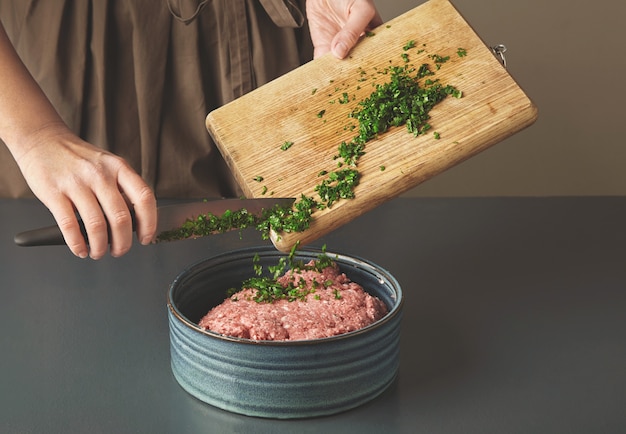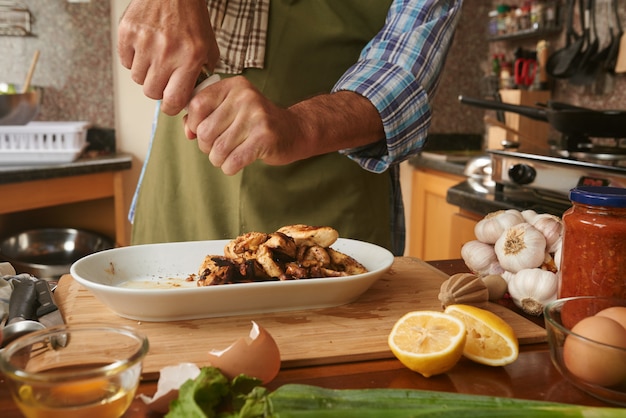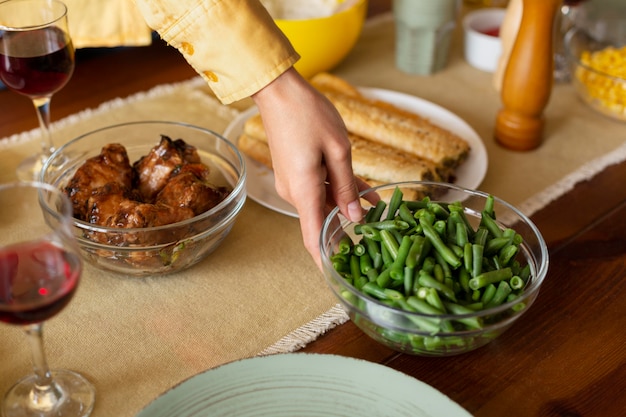(Part 1) The What and Why of Corned Beef

What is Corned Beef?
First things first, let's clarify what exactly corned beef is. It's essentially beef brisket that's been cured in a brine. This brine is a mix of salt, sugar, and spices like black peppercorns and coriander. The process gives the beef its distinctive salty flavor and tender texture. Think of it like a salty, flavorful version of bacon. It's a bit like a salty, flavorful version of bacon, if you will. You know, that kind of salty, flavorful, tender beef you just can't resist.
Why is it Called "Corned" Beef?
Now, the name "corned" might seem a bit odd, especially if you're picturing corn on the cob. It actually comes from the large grains of salt that were used to cure the beef back in the day. These grains were called "corns" of salt, hence the name. It's a bit of a historical quirk, but it's definitely part of the corned beef story.
(Part 2) Choosing the perfect corned beef

Brisket vs. Round
You’ll usually find two main types of corned beef in the shops: brisket and round. Brisket is the more traditional choice, and it's got a good amount of fat marbling. This marbling is key, folks, because it melts during cooking, making the brisket incredibly tender. Round, on the other hand, is leaner. This means it might need a bit more cooking time to prevent it from drying out. However, it's also a bit cheaper than brisket, so if you're on a budget, it's a good option.
Checking the Quality
When you're choosing your corned beef, take a moment to really examine it. Check for any signs of discolouration or off smells. The meat should be firm and have a good, even colour. Also, check the packaging date. You want to make sure it's fresh and hasn't been sitting around for too long. Nobody wants a stale corned beef!
The Nitty-Gritty of Choosing Your Corned Beef
Here's a quick breakdown of the key points to consider:
- Type: Brisket is the traditional choice, but round is a good budget-friendly option. It's really a matter of preference and what you're looking for.
- Look: Check for a good colour, firmness, and no signs of spoilage. You want to make sure you’re getting a quality cut of meat.
- Packaging Date: Make sure it's fresh! You want to ensure that it's been stored properly and hasn't gone past its prime.
(Part 3) Preparing Your Corned Beef

Rinse and Drain
Before you start cooking, you need to rinse your corned beef thoroughly under cold water. This washes away any excess salt from the curing process. It's important to get rid of that excess salt to prevent the corned beef from being overly salty. Once you've rinsed it well, pat it dry with paper towels. This helps remove any excess moisture and ensures a nice even cooking.
Removing the Packaging
Most corned beef comes in a plastic wrapping, which you need to remove. Sometimes, there’s a spice packet inside the packaging. You can use this packet, or you can choose your own blend of spices. If you want to go the extra mile, you can make your own corned beef rub. I've got a recipe for that later in the guide!
(Part 4) Cooking Your Corned Beef: The Classics
Boiling it Up
This is the most classic and straightforward way to cook corned beef. It's simple, but it still yields a delicious result. Just pop the corned beef into a large pot, cover it with water, and bring it to a boil. Then, reduce the heat and simmer for about 2-3 hours, or until the meat is fork-tender. You know it's ready when you can easily poke a fork into the meat and it comes apart easily.
The Vegetables
While the corned beef is simmering, you can add some vegetables like carrots, potatoes, and onions to the pot. These will infuse the broth with flavour and become delicious side dishes for your corned beef. It’s a win-win – you get flavorful vegetables and a more flavorful broth. You can even add a few bay leaves for extra depth of flavor.
Boiling Time
The cooking time will depend on the size of your corned beef. A smaller brisket might only take about 2 hours, while a larger one could take closer to 3 hours. You can test if it's cooked through by poking it with a fork. If it goes in easily and the meat comes apart easily, then it's ready. It's always better to err on the side of caution, though. You can always cook it for a bit longer if you're not sure.
(Part 5) Cooking Your Corned Beef: Taking it Up a Notch
Slow Cooking: The Ultimate Tenderness
If you're looking for the ultimate in tenderness, slow cooking is the way to go. It's a great option for busy people because you can just pop the corned beef in the slow cooker in the morning and have a delicious meal ready for dinner. Just place the corned beef in the slow cooker, add some water or broth, and cook on low for 8-10 hours, or on high for 4-6 hours. The slow cooking process really breaks down the tough fibers in the brisket, making it incredibly tender. It's a real crowd-pleaser.
Flavor Boost: The Rub
Now, here’s where you can really elevate your corned beef game. A good rub can add a whole new dimension of flavor. You can find pre-made rubs at the store, or you can make your own. There are countless recipes online, but here's my personal favourite:
My Go-To Corned Beef Rub
This recipe is really simple, but it delivers a great smoky and spicy flavour:
| Ingredient | Quantity |
|---|---|
| Brown Sugar | 2 tablespoons |
| Smoked Paprika | 1 tablespoon |
| Garlic Powder | 1 tablespoon |
| Onion Powder | 1 tablespoon |
| Black Pepper | 1 tablespoon |
| Cayenne Pepper | 1/2 teaspoon |
Mix all the ingredients together and rub it all over the corned beef before cooking. The sugar helps caramelize the outside and adds a touch of sweetness, the paprika gives it a smoky flavour, and the garlic, onion, and pepper spices it up nicely. This combination of sweet, smoky, and spicy flavours creates a truly unique taste sensation.
(Part 6) Corned beef broth: The Magic Elixir
Don't Waste the Broth
Once your corned beef is cooked, don't throw away the broth! It's a flavour bomb that can be used for so many delicious things. You can use it to make a hearty soup, a flavorful gravy for your corned beef, or even just as a base for a comforting cup of broth.
Broth for Soup
To make a soup, simply remove the corned beef from the broth and let it cool. Then, skim off any excess fat from the surface of the broth. This helps to make the soup lighter and less greasy. You can use this broth as the base for a classic corned beef and cabbage soup, or get creative and add other vegetables like carrots, potatoes, and celery. You can even throw in some barley or noodles for a heartier soup.
Broth for Gravy
For a rich and flavorful gravy, thicken the broth with cornstarch or flour. This will give it a creamy consistency and make it stick to your corned beef. You can add some of the cooked vegetables from the pot to the gravy for extra flavour. It's a perfect accompaniment for your corned beef.
(Part 7) Serving Up Your Corned Beef: The Feast
Slicing and Dicing
Once the corned beef is cooked, let it cool slightly before slicing it. You can slice it thin for sandwiches or thicker for a more substantial meal. If you’re making a cold corned beef sandwich, it’s best to chill the sliced corned beef in the fridge for a few hours before serving. This helps to firm up the meat and enhance the flavor.
Classic Side Dishes
Corned beef is traditionally served with boiled vegetables like carrots, potatoes, and cabbage. These are classic side dishes for a reason. They pair perfectly with the salty, savory flavor of the corned beef. For a bit of colour, try adding some steamed broccoli or green beans to the mix. The combination of textures and flavors creates a truly satisfying meal.
Beyond the Classics
You can also get creative with your side dishes. Try serving your corned beef with a side of creamy coleslaw, a bright and tangy potato salad, or a fresh green salad. These options offer a nice contrast to the richness of the corned beef and add a touch of freshness to the meal.
Sandwiches, Sandwiches, Sandwiches!
Of course, no corned beef feast is complete without some delicious sandwiches. You can simply pile sliced corned beef on rye bread with mustard, or get a little fancier with a reuben sandwich. A reuben sandwich is a classic corned beef sandwich with sauerkraut, Swiss cheese, and Thousand Island dressing on rye bread. It's a real treat, and a perfect way to showcase the flavor of corned beef.
(Part 8) Leftover Love: What to do with Corned Beef
Second Helpings
leftover corned beef is a real treat. You can make more sandwiches, or get creative with some other recipes. Leftovers are a great opportunity to get a second meal out of your corned beef, and often even tastier!
Hash It Up!
Corned beef hash is a classic way to use up leftover corned beef. Simply dice up the corned beef, combine it with potatoes, onions, and other vegetables, and pan-fry it until crispy. It's a hearty and delicious breakfast or brunch dish. And it's a great way to use up those leftover potatoes and vegetables from your corned beef dinner.
Soup's On
You can also use leftover corned beef to make a delicious soup. Simply add the corned beef to a pot of broth with other vegetables like carrots, potatoes, and celery. It’s a comforting and flavorful soup that’s perfect for a chilly day. You can even add a dollop of sour cream or a sprinkle of fresh herbs for an extra touch of flavor.
Pasta Perfection
If you’re feeling adventurous, you can even use leftover corned beef in pasta dishes. Try adding it to a creamy carbonara or a hearty puttanesca. It’s a unique way to add a salty, savory flavor to your pasta. And the combination of textures is quite delicious.
(Part 9) FAQ: Your Corned Beef Questions Answered
1. Can I Cook Corned Beef from Frozen?
It’s perfectly fine to cook corned beef from frozen. Just add an extra hour or two to the cooking time to make sure it cooks thoroughly. Make sure to thaw it completely before slicing and serving, though. You don't want to be slicing a frozen brick of meat!
2. How Long Can I Keep Corned Beef in the Fridge?
Cooked corned beef can be stored in the refrigerator for up to 4 days. Just make sure to store it properly in an airtight container to keep it fresh and prevent it from drying out. It’s always best to eat it within a few days for optimal flavor and texture.
3. Can I Freeze Corned Beef?
Yes, you can freeze corned beef for up to 3 months. It's best to freeze it before cooking, as freezing it after cooking can make it dry out a bit. Make sure to wrap it tightly in freezer paper or plastic wrap to prevent freezer burn. When you’re ready to use it, thaw it in the refrigerator overnight before cooking.
4. How Do I Know When Corned Beef is Cooked?
The best way to tell if corned beef is cooked is to check the internal temperature. It should reach 145°F (63°C). You can also test it by poking it with a fork. If it goes in easily and the meat comes apart easily, it's cooked through. If you're not sure, it's always better to cook it a bit longer.
5. Can I Cook Corned Beef Without Brine?
You can certainly cook corned beef without a brine, but you'll need to season it well with salt, pepper, and other spices. You can also use a dry rub to enhance the flavor. Just make sure you season it generously to compensate for the lack of brine.
(Part 10) Conclusion: A Feast for the Senses
There you have it, my complete guide to cooking corned beef. From choosing the perfect cut to serving it up with delicious side dishes, you’ve got all the information you need to create a delicious and satisfying meal. So, next time you’re looking for a hearty and flavorful dish, remember this guide. It’s your ticket to a delicious corned beef feast!
Everyone is watching

Prime Rib Roast Cooking Time Chart: Per Pound Guide
Cooking TipsPrime rib roast. Just the name conjures images of lavish dinners, crackling fires, and hearty laughter. It’s ...

How Long to Bake Potatoes in the Oven (Perfect Every Time)
Cooking TipsBaked potatoes are a staple in my kitchen. They're incredibly versatile, delicious, and surprisingly easy to m...

Perfect Rice Every Time: The Ultimate Guide to Cooking Rice
Cooking TipsAs a self-proclaimed foodie, I've always been a bit obsessed with rice. It's the foundation of countless cuisi...

The Ultimate Guide to Cooking Asparagus: Tips, Techniques, and Recipes
Cooking TipsAsparagus. The mere mention of this spring delicacy conjures up images of vibrant green spears, crisp and burs...

Ultimate Guide to Cooking the Perfect Thanksgiving Turkey
Cooking TipsThanksgiving. Just the word conjures up images of overflowing tables laden with delicious food, the scent of r...
